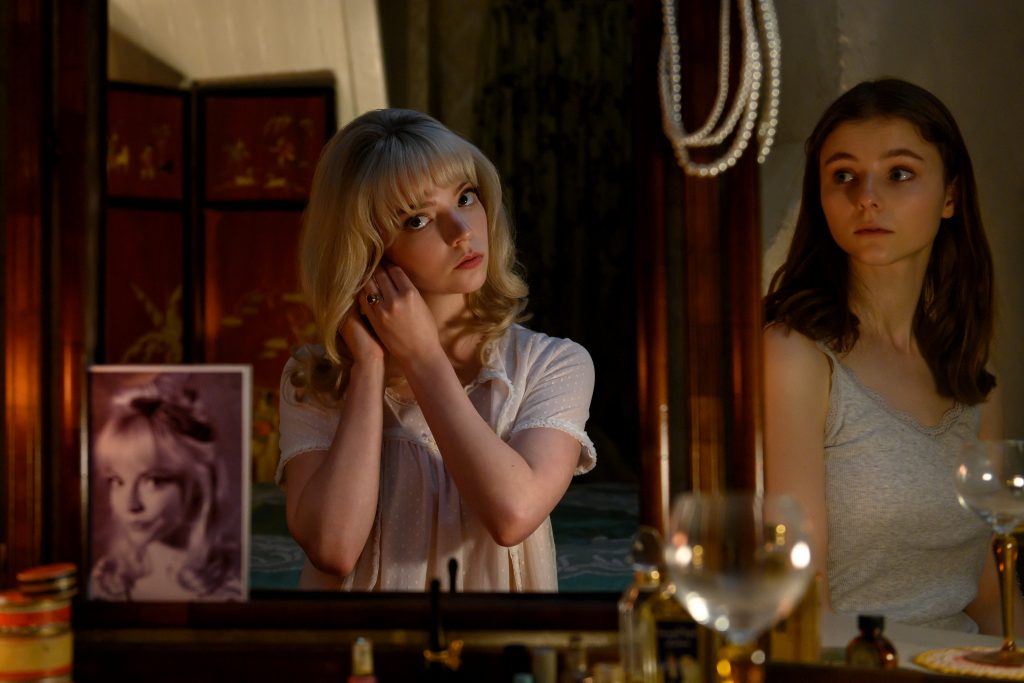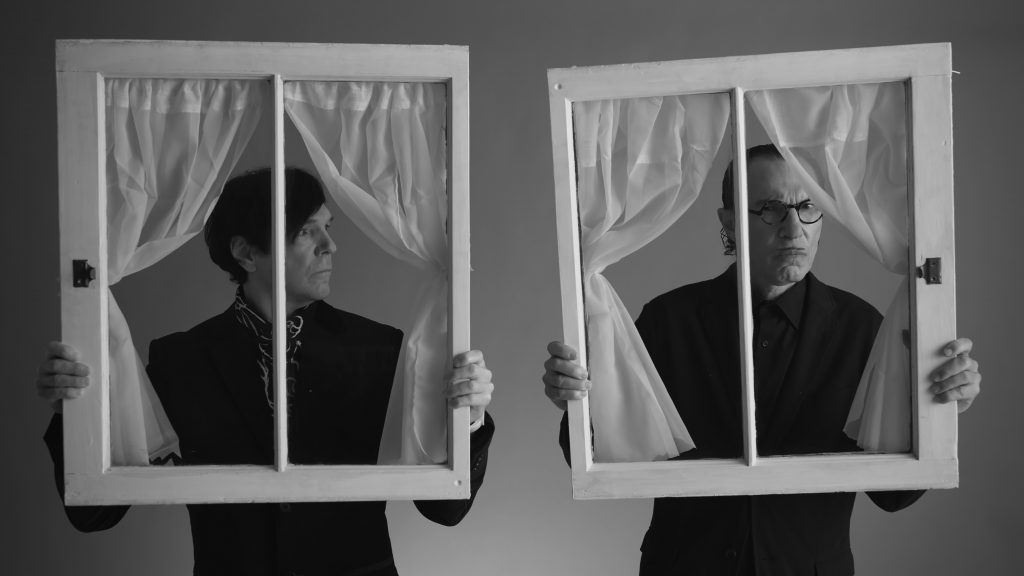October 28, 2021
by Carla Hay

Directed by Edgar Wright
Culture Representation: Taking place in England (mostly in London), the horror film “Last Night in Soho” features a predominantly white cast of characters (with some black people) representing the working-class, middle-class and wealthy.
Culture Clash: A fashion student in London has nightmarish visions of a nightclub singer from the 1960s.
Culture Audience: “Last Night in Soho” will appeal primarily to people who are fans of filmmaker Edgar Wright and horror stories that have intriguing murder mysteries.

Stylish and unnerving, “Last Night in Soho” is a mind-bending, time-jumping psychological horror movie that is riveting from beginning to end. The movie wears its retro influences (such as Italian giallo horror movies) on its vibrantly hued cinematic sleeves. It’s an homage to Swinging London in the 1960s as much as it’s a nod to how feminist issues have changed (or remained the same) since then. “Last Night in Soho” gets a little too conventional in its last 15 minutes, but the movie overall is an above-average thriller that’s elevated by compelling performances. Get ready for a spooky and fabulous ride.
Edgar Wright directed “Last Night in Soho” and co-wrote the screenplay with Krysty Wilson-Cairns. Wright is also one of the movie’s producers. Although “Last Night in Soho” is not the first horror movie from Wright (his filmography includes the zombie flick “Shaun of the Dead,” his 2004 feature-film debut), “Last Night in Soho” is a departure for Wright in many ways. And it was a risk that paid off to be one of his most accomplished films in years.
For starters, “Last Night in Soho” is Wright’s first movie where women are the main protagonists. As such, it made sense that he collaborated with a female screenwriter for the movie; it’s the first time there’s a female co-writer on a feature film that he’s directed. “Last Night in Soho” also marks a big change in Wright’s typical comedic tone for his movies, because “Last Night in Soho” is most definitely not a horror comedy. The movie does not let up in its intent to terrify and keep viewers on edge to see what happens next. And, for a lot of people, that’s the best kind of horror movie.
“Last Night in Soho” begins with a whimsical opening sequence of British protagonist Eloise Turner (played by Thomasin McKenzie), a young woman in her late teens, who is at her home in a small town in England’s Cornwall county. She’s whirling around and dancing joyfully in a mid-length flare gown made of newspaper, as Peter and Gordon’s 1964 hit “A World Without Love” plays on her turntable in her bedroom. It’s a gown that Eloise designed herself because she’s an aspiring fashion designer, but she doesn’t have the money for luxurious fabric.
Eloise has a pixie-ish, otherworldy air about her, almost like she stepped out from a time machine from the 1960s. However, Eloise isn’t from the 1960s, the era of her grandmother’s youth. Eloise is currently living in the early 2020s, but she has a fascination with pop culture and fashion from the 1960s. Her collection of vinyl records consists almost entirely of 1960s music. She also prefers literature and movies from the 1960s.
Eloise is a shy loner who lives with her widowed grandmother Peggy (played by Rita Tushingham) in a cozy house. A love of fashion runs in the family. Peggy is a seamstress. Eloise’s unnamed mother (Peggy’s daughter) was also an aspiring fashion designer. Tragically, Eloise’s mother committed suicide when Eloise was 7. Eloise’s father has not been in her life. Viewers will get the impression that Eloise’s father was never in her life because she never talks about him.
Peggy is a loving and somewhat over-protective grandmother, whose nickname for Eloise is Ellie. Eloise and Peggy have mutual respect for one another, but it become immediately apparent that Eloise (who recently graduated from high school) is restless and ready to move out and into her own place. Eloise applied to London College of Fashion, a prestigious institute. And when Eloise gets the acceptance letter in the mail, she’s elated.
Eloise breaks the news to Peggy, whose response is more cautious. London is where Peggy’s daughter moved to pursue her fashion career too. It’s implied that Peggy somewhat blames London for aggravating whatever led to the suicide of her daughter. Peggy warns Eloise: “London can be a lot … Your mother didn’t have your gift.” And Peggy isn’t talking about the gift of fashion designing.
It doesn’t take long for the movie to reveal that Eloise has psychic abilities. The first big clue is in the opening scene, when Eloise looks in her bedroom mirror while wearing her homemade dress, and she sees her mother smiling and standing next to her. Aimee Cassettari portrays Eloise’s mother, who appears in Eloise’s visions more than once in the movie.
Eloise is legally an adult, so she’s free to live on her own. Peggy doesn’t discourage Eloise from pursuing her dreams, but she tells her granddaughter that she’s welcome to move back with Peggy in this small town if things don’t work out for Eloise in London. And so, with a bittersweet farewell where they try not to break down and cry, Eloise has her bags packed and drives off in a taxi to her new life in the big city.
Eloise has been assigned to live in a hotel-like dormitory with other students from London College of Fashion. Her roommate is the talkative and worldly Jocasta (played by Synnøve Karlsen), who is also a first-year student at the fashion institute. Jocasta is originally from Manchester and thinks of herself as the hippest queen bee at the school.
The first sign of Jocasta’s pretentiousness is when she insists that no one use her last name. She explains that she wants to be a one-name celebrity. “Just like Kylie,” Jocasta tells Eloise. “Kylie Minogue?” asks Eloise. “No,” Jocasta says with exasperation, as if Eloise is stuck in the 20th century. “Kylie Jenner!”
In their first conversation together, Eloise and Jocasta tell each other a little bit about their backgrounds. When Eloise says where she’s from, Jocasta says in a pitying voice, “I’m sorry,” as if she really meant to say, “I’m sorry you’re a country bumpkin from a small town.” Jocasta also seems amused by Eloise’s homemade clothes, which Jocasta obviously thinks are unfashionable, unflattering and unsophisticated.
Jocasta softens up a little when she mentions that her mother is also dead: She passed away from leukemia when Jocasta was 15. But that empathetic side to Jocasta is short-lived. She has a “mean girl” streak that Eloise sees for the first time when she hangs out at a pub with Jocasta and three other female students from the dorm: Lara (played by Jessie Mei Li), Cami (played by Kassius Nelson) and Ashley (played by Rebecca Harrod), who do not have distinguishable personalities and are essentially echo chambers for Jocasta’s bullying nature.
On this night out, Eloise quickly notices that Jocasta, who seemed friendly to her in their first meeting, is actually mocking Eloise when she thinks Eloise isn’t looking. Jocasta also influences her cronies to laugh at Eloise too. At Eloise’s first time going to a dorm party in London, she’s timid, socially awkward, and isn’t interested in getting drunk or stoned like many of the other partiers.
When a drunk guy (played by Josh Zaré) aggressively flirts with Eloise at the party, a nice guy classmate from the fashion institute gets the rude partier to back off of Eloise. The gentleman student introduces himself to Louise. His name is John (played by Michael Ajao), and it’s obvious that he feels an immediate attraction to Eloise, who is inexperienced in dating. Eloise gets uncomfortable when she senses that men want to act on their sexual attraction to her. John is respectful to her and tries to initiate a friendship with Eloise. The movie shows how their relationship develops over time.
At London College of Fashion, Eloise gets encouragement in the classroom from a teacher named Ms. Tobin (played by Elizabeth Berrington), who thinks Eloise has a lot of talent and potential. Jocasta and her gaggle of mean girls continue with their catty whispering and thinly veiled insults directed at Eloise, who tries to ignore them. But the last straw for Eloise is when she overhears Jocasta telling the other girls in the clique that Eloise’s mother committed suicide, and Jocasta predicts that Eloise will go crazy and drop out of the school.
It’s enough for Eloise to look for a new place to live. She answers an ad to rent a room in a house owned by an elderly woman named Ms. Collins (played by the Diana Rigg), who is a no-nonsense landlord. Ms. Collins bluntly tells Eloise some of the rules of the house, including no male visitors after 8 p.m. and no loud partying. Rigg (who died in 2020, at he age of 82) was quite a casting coup for “One Night in Soho,” since she was a 1960s icon for her role as Emma Peel in “The Avengers” TV series.
It’s why there’s an air of authenticity to the story when Ms. Collins reminisces about her heyday in the 1960s. It’s a topic that Eloise is fascinated by, and Ms. Collins is pleasantly surprised by how much knowledge and reverence that Eloise has for 1960s culture. Eloise thinks she’s found an ideal place to live. But maybe Eloise should’ve paid more attention when Ms. Collins demanded two months’ rent as a deposit (instead of the usual one month’s rent), because Ms. Collins said that previous tenants had a tendency to quickly move out and break their lease.
Eloise’s bedroom is directly across from a business that flashes neon red and blue lights all night, so her room is often bathed in red and blue at night. It’s a striking visual motif that’s used throughout the movie and becomes increasingly sinister as the story goes on, and red becomes the dominant shade. At first, Eloise doesn’t mind the distraction of these blinking lights.
But then, Eloise’s seemingly peaceful existence in her new home is shattered when she starts having vivid nightmares. In these nightmares, Eloise has stepped back into the mid-1960s and is an invisible observer of the turbulent life of an ambitious, aspiring pop singer in her early 20s named Sandie (played by Anya Taylor-Joy), who’s looking for her big break at any nightclub that will book her. (Sandie spends a lot of time in London’s Soho district.) In these dreams/visions, Eloise can see herself in mirrors, but the people in the dreams can’t see her.
At times, it looks like Eloise has morphed into Sandie in these dreams. But it soon becomes apparent that it’s just wishful thinking from Eloise, who has a growing admiration of Sandie. At first, Eloise seems enchanted by what she thinks is Sandie’s glamorous and sexy life. Sandie is everything that Eloise is not: confident, extroverted, and someone who is unafraid to go after what she wants. Sandie also ends up influencing how Eloise designs clothes and how Eloise undergoes a makeover.
Sandie begins dating a slick, smooth-talking manager named Jack (played by Matt Smith), who has several female pop stars as his clients, including Cilla Black (played by Beth Singh), who has a brief singing performance in the movie. But (you knew this was coming), Jack is a playboy. And even though he helps Sandie with her career, at what cost will it come to Sandie’s heart or her life? As time goes on, Eloise’s dreams about Sandie become increasingly ominous until she’s certain that Sandie’s life is in danger.
Eloise is haunted by the feeling that Sandie was a real person, not a figment of Eloise’s imagination. Much of “Last Night in Soho” involves the untangling of this mystery. Eloise’s dreams-turned-nightmares about Sandie start to negatively affect Eloise at school, because she starts having alarming visions of Sandie during the day. Expect to see Eloise have more than one public freakout in this movie. Eloise and some of the people around her start to wonder if she’s going crazy.
Adding to the mystery, there’s an elderly man (played by Terence Stamp) who seems to be following Eloise, ever since she arrived in London. The identity of this man is eventually revealed. Meanwhile, when Eloise talks to her grandmother on the phone, Eloise pretends that everything is just fine.
“Last Night in Soho” has such great attention to detail in the movie’s production design and costume design, it’s an absolute visual treat to watch this movie. This is a movie that namechecks Biba, the now-defunct but still legendary department store that was a mecca for Swinging London fashionistas. In addition, “Last Night in Soho” has a well-chosen soundtrack (not just 1960s music) that perfectly conveys the mood that the filmmakers want for each scene. Petula Clark’s 1964 hit “Downtown” is used in a standout sequence.
But all of these assets would be wasted if the actors’ performances in the movie were substandard. All of the principal cast members bring emotional authenticity to their roles. Fortunately, McKenzie and Taylor-Joy, who are the heart and soul of the movie, give fascinating performances, filled with angst, happiness, vulnerability, strength and hope. Taylor-Joy does her own singing in some dazzling scenes where Sandie is showcased on stage. Taylor-Joy is American-born with an upbringing in Buenos Aires and London, so her British accent is authentic. In real life, McKenzie is from New Zealand, and her British accent in the movie is entirely believable.
Eloise and Sandie are two young women living in London and who seem to have very different lives and contrasting personalities. However, Eloise and Sandie share some things in common: They have to make decisions about how they want to pursue their dreams and how much they want their careers to be a part of their identities. And they both have no family in London and no real friends to turn to for support, so they have to make it on their own while navigating the emotional treachery of people who want to demean them.
“Last Night in Soho” also demonstrates larger issues that are relatable to women, such as thoughts and safety precautions that women have to experience when they are traveling alone that aren’t as major issues for men who travel alone. There’s a very realistic scene of Eloise trying to get herself out of a creepy situation when a middle-aged taxi driver (played by Colin Mace) tries to take advantage of her being new to London when Eloise is his passenger. At first, the driver appears to be friendly and chatty, but it soon becomes obvious he’s just trying to fish for private information about Eloise. He then tells Eloise in no uncertain terms that he’d like to get to know her better.
Eloise knows exactly what he means and what he wants. She astutely decides to be dropped off at a grocery store instead of her intended destination. Eloise peeks apprehensively from the store window as the taxi driver, like a stalker, waits in his car and watches for her to come out of the store. And she breathes a sigh of relief when he eventually drives off. Most women and teenage girls have experienced this type of stalker-ish unwanted attention.
Aside from Eloise’s nightmares, the movie lays bare the constant threat and damage of sexual harassment and sexual degradation that could always be a possibility when men with power decide to abuse their power with women. Even though Eloise is invisible to the people in Sandie’s world, Eloise becomes very protective of Sandie, who’s vulnerable to this type of disrepectful treatment. And this protectiveness taps into a rage that represents what a lot of women feel when they go through the same type of misogyny.
Eloise’s invisibility is symbolic of how many women feel invisible and powerless to stop this societal problem. “Last Night in Soho” does not get bogged down in any feminist preaching, and it does not lose sight of its intention to be a horror movie. But it’s a horror movie that will make viewers think beyond the gory scenes and think about what can happen when a feminine psyche is pushed to the limits.
Focus Features will release “Last Night in Soho” in U.S. cinemas on October 29, 2021.


